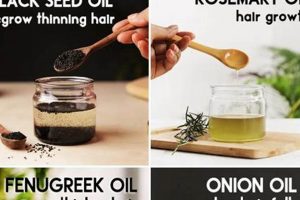The phrase refers to the process of lightening specific strands of dark-colored hair using methods and products intended for application outside of a professional salon environment. An example would be using a boxed hair dye kit purchased at a retail store to create lighter streaks in naturally black or dark brown hair at home.
Executing this process offers individuals control over the costs associated with hair coloring, and it provides the convenience of modifying one’s appearance within the comfort and privacy of a personal residence. Historically, this type of at-home hair alteration has grown in popularity alongside the increasing availability and affordability of hair dye products designed for consumer use.
Subsequent sections will address crucial aspects, including selecting appropriate products for dark shades, employing safe application techniques, and maintaining the health and vibrancy of the treated hair.
Essential Considerations for Achieving Desired Results
This section outlines key strategies for successfully lightening dark hair at home. Adhering to these recommendations can mitigate damage and improve the overall outcome.
Tip 1: Conduct a Strand Test: Prior to full application, test the chosen product on a small, inconspicuous section of hair. This assesses color development and potential adverse reactions, preventing widespread disappointment or damage.
Tip 2: Select the Appropriate Developer Volume: Dark hair often requires a higher developer volume to achieve noticeable lightening. However, excessive volume can cause significant damage. A 20-volume developer is generally recommended for initial attempts, with adjustments made based on the strand test results. Proceed with caution; incremental changes are preferable to irreversible damage.
Tip 3: Utilize a Toning Product: Lightening dark hair frequently reveals underlying warm tones, such as orange or red. A toner neutralizes these unwanted hues, resulting in a more balanced and aesthetically pleasing final color. Select a toner formulated for the specific undesired tones present.
Tip 4: Employ a Professional-Grade Lightening Kit: While readily available drugstore kits are accessible, professional-grade products often offer greater control and predictability. These kits typically contain higher-quality ingredients and provide more precise color formulation options.
Tip 5: Practice Proper Application Techniques: Distribute the product evenly throughout the intended sections of hair. Use appropriate tools, such as a highlighting brush or foil, to achieve desired placement. Avoid overlapping previously lightened sections to prevent over-processing and breakage.
Tip 6: Deep Condition Regularly: Lightening processes strip hair of its natural moisture. Consistent deep conditioning treatments are essential for restoring hydration, strengthening the hair shaft, and minimizing breakage. Implement a weekly deep conditioning regimen.
Tip 7: Protect Hair from Heat: Heat styling tools can exacerbate damage to chemically treated hair. Minimize heat exposure and always use a heat protectant spray prior to styling. Opt for air-drying whenever possible.
By carefully considering these suggestions, individuals can better navigate the complexities of lightening dark hair at home, increasing the likelihood of achieving satisfactory results while minimizing potential harm.
The subsequent section will delve into potential challenges and solutions to common problems that may arise during the hair-lightening process.
1. Color Selection
The selection of appropriate colors for highlights in the context of DIY dark hair lightening is a critical determinant of success. The desired aesthetic outcome is directly and profoundly influenced by the choice of highlighting shade. Inappropriate color selection can result in an unnatural appearance, highlighting brassy undertones rather than creating the intended dimension and brightness. For instance, selecting a shade that is too light for the base hair color can create stark contrast, resulting in a zebra-like effect, while a color too close to the base shade might render the highlights virtually invisible. Therefore, understanding the underlying warm tones present in dark hair and selecting a toner that neutralizes those tones becomes an integral aspect of the color selection process for this do-it-yourself undertaking.
Furthermore, the selection process must consider the specific method being employed. Balayage, for example, might benefit from warmer, softer tones to create a sun-kissed effect, while traditional foil highlights could benefit from a cooler color spectrum to provide enhanced contrast. A real-world example of poor color selection involves the use of a high-lift blonde on naturally dark brown hair without proper pre-lightening, leading to an orange or yellow hue. This undesirable result underscores the necessity for meticulous color consideration, potentially including multiple steps to achieve the intended shade while minimizing damage.
In summary, color selection within the domain of at-home dark hair highlighting represents a complex and vital step. Its successful execution requires an understanding of color theory, hair undertones, and the chosen application method. The challenges inherent in selecting suitable highlighting colors for dark hair underscore the importance of cautious planning and potentially seeking professional advice to mitigate potential adverse effects and maximize the desired aesthetic impact.
2. Product Quality
The success and safety of creating highlighted effects on dark hair using DIY methods are inextricably linked to the quality of the products employed. Inferior products may contain inconsistent or excessively harsh chemicals, increasing the risk of damage, uneven color development, and undesirable brassy tones. For instance, a low-quality developer might not lift the hair to the desired level, resulting in muddy or indistinct highlights. Conversely, an overly aggressive developer can lead to breakage, dryness, and compromised hair integrity. The selection of high-quality lighteners, developers, and toners is, therefore, not merely a preference but a necessity for achieving satisfactory and sustainable results.
Furthermore, professional-grade products often incorporate buffering agents and conditioning ingredients that mitigate the damaging effects of the lightening process. This is in stark contrast to many drugstore brands that may prioritize cost-effectiveness over hair health. The investment in superior products directly translates to a reduced likelihood of needing extensive corrective treatments or facing long-term hair damage. Consider the scenario where two individuals attempt a similar highlighting technique, one using a premium lightening kit and the other utilizing a generic brand. The former is more likely to achieve even lift, minimal damage, and a predictable color outcome, while the latter risks unpredictable results and significant compromise to the hair’s structural integrity.
In conclusion, the quality of products represents a critical, often underestimated, component of DIY hair highlighting, particularly for individuals with dark hair. Compromising on product quality introduces substantial risks to both the aesthetic outcome and the overall health of the hair. The informed consumer understands the cause-and-effect relationship between product quality and results, thereby making informed decisions that prioritize safety and efficacy. While professional services provide a degree of assurance, selecting superior-grade products forms the foundation for successful and sustainable at-home hair highlighting endeavors, thereby helping mitigate many potential issues.
3. Application Technique
Application technique is a pivotal determinant in the success or failure of at-home dark hair highlighting endeavors. The method by which lightener is applied directly impacts the placement, saturation, and overall aesthetic of the finished highlights. Improper application can result in uneven color distribution, harsh lines, and unintended brassiness, ultimately detracting from the desired outcome. For instance, failing to saturate the hair adequately with lightener will produce patchy, uneven highlights, while overlapping previously lightened sections leads to over-processing and potential breakage. Therefore, understanding and meticulously executing appropriate application techniques is essential for achieving professional-looking results when highlighting dark hair at home.
The specific technique employed must also align with the desired style. Foil highlighting, for example, allows for precise placement and controlled lift, making it suitable for creating defined, uniform highlights. In contrast, the balayage technique, which involves hand-painting the lightener onto the hair, produces a more natural, blended effect. Incorrectly using either of these methods can lead to suboptimal results. Consider an individual attempting a balayage effect using rigid foil placement; the resulting highlights would likely appear unnatural and stripey, lacking the soft, diffused transitions characteristic of the balayage style. Adhering to established guidelines for each technique, including sectioning, product saturation, and development time, is paramount.
In summary, the application technique exerts a significant influence on the final appearance of DIY dark hair highlights. Mastery of the chosen technique, combined with careful attention to detail, greatly increases the likelihood of achieving the intended aesthetic. Conversely, neglecting proper application techniques can lead to undesirable and potentially damaging outcomes. This emphasizes the necessity for thorough research, practice, and patience when undertaking this complex hair alteration process at home, especially for individuals with dark hair seeking professional-quality results.
4. Hair Health
The health and integrity of the hair are fundamental considerations when undertaking any DIY highlighting process, particularly on dark hair. The chemical processes involved in lightening inherently alter the hair’s structure, potentially leading to damage if precautions are not taken. Therefore, assessing pre-existing hair condition and implementing preventative measures are crucial aspects of successful at-home highlighting.
- Pre-Existing Condition Assessment
Prior to attempting highlights, individuals must evaluate the state of their hair. Pre-existing damage from heat styling, previous chemical treatments, or environmental factors increases vulnerability to further harm from lightening. Hair that is already dry, brittle, or prone to breakage is at a higher risk. Attempting a DIY highlighting process on compromised hair may result in severe damage, including breakage and irreversible texture changes. A practical example involves assessing the hairs elasticity; healthy hair should stretch and return to its original length without breaking. If the hair snaps easily, it indicates compromised protein structure, necessitating restorative treatments before any lightening process.
- Moisture Balance and Protein Levels
Maintaining a proper balance of moisture and protein is vital for hair health, particularly when chemical treatments are involved. Lightening processes can strip the hair of its natural oils and compromise its protein structure, leading to dryness and weakness. Incorporating deep conditioning treatments and protein masks into a hair care regimen is essential to counteract these effects. For example, using a deep conditioning mask containing ingredients like shea butter or argan oil can help replenish lost moisture, while protein treatments containing keratin can strengthen the hair shaft and reduce breakage.
- Product Selection and Application
Choosing appropriate products and employing proper application techniques are critical for minimizing damage during the highlighting process. Opting for lower-volume developers and limiting processing time reduces the risk of over-processing. The application method also plays a significant role; even distribution of the product and avoiding overlap on previously lightened sections prevent uneven results and unnecessary damage. A practical illustration involves carefully applying lightener to thin sections of hair using a brush, ensuring even saturation and avoiding contact with the scalp to minimize irritation.
- Post-Highlighting Care and Maintenance
Following the highlighting process, consistent care and maintenance are crucial for preserving hair health and color vibrancy. Regular deep conditioning treatments, the use of sulfate-free shampoos, and minimizing heat styling are all essential components of a post-highlighting care routine. Additionally, incorporating leave-in conditioners and hair oils can help protect the hair from environmental damage and maintain its moisture balance. For example, applying a lightweight hair oil containing UV protectants before sun exposure can help prevent color fading and protect the hair from the drying effects of the sun.
These facets underscore the intricate relationship between hair health and the success of DIY highlighting endeavors. Prioritizing hair health through careful planning, product selection, and consistent maintenance not only enhances the aesthetic outcome but also safeguards the long-term integrity and vitality of the hair.
5. Toning Process
The toning process is an indispensable step in the realm of do-it-yourself highlighting of dark hair. This stage serves to refine the color achieved during the lightening process, neutralizing unwanted undertones and ensuring the highlights blend harmoniously with the base hair color. Without proper toning, DIY highlights on dark hair are prone to exhibiting undesirable brassy or orange hues, detracting from the intended aesthetic.
- Neutralization of Underlying Pigments
Dark hair inherently contains warm pigments, typically red or orange, which are revealed during the lightening process. Toning products, containing pigments complementary to these unwanted tones, effectively neutralize them. For example, a toner with blue or purple pigments counteracts orange and yellow tones, respectively. Failure to neutralize these pigments results in highlights that appear brassy or unnatural. Consider a scenario where dark brown hair is lightened to a level revealing strong orange undertones; without a blue-based toner, the highlights will retain this orange cast, appearing less refined.
- Color Correction and Blending
Beyond mere neutralization, the toning process enables color correction, allowing individuals to fine-tune the shade of their highlights. This is particularly useful in DIY settings where achieving the precise desired shade in a single lightening session can be challenging. Toning enables blending highlights with the base color. For instance, if the highlights are too bright or stark, a toner can soften the contrast, creating a more seamless transition. Individuals can thus manipulate toners to create desired looks from more natural, subtle enhancements, to eye catching high contrast styles.
- Enhancing Shine and Depth
Many toning products contain ingredients that enhance the shine and depth of the hair. These formulations deposit a subtle layer of pigment and often include conditioning agents that smooth the hair cuticle, reflecting light more effectively. This is especially beneficial for highlighted dark hair, which can become dry and porous during the lightening process. Consequently, a well-executed toning process not only corrects color but also improves the overall appearance and texture of the hair.
- Maintaining Highlight Longevity
The toning process can extend the longevity of highlights by sealing the hair cuticle and preventing color fading. Toning products deposit pigments that help to fill in gaps in the hair shaft, reducing porosity and improving color retention. Regular toning touch-ups can help to maintain the desired shade and prevent the reappearance of unwanted undertones over time. This is particularly important for DIY highlighting, where professional-grade maintenance might not be readily accessible.
In conclusion, the toning process constitutes a critical element in the pursuit of successful DIY dark hair highlights. Its multifaceted role, encompassing pigment neutralization, color correction, shine enhancement, and color longevity, makes it an indispensable step for achieving professional-looking results at home. Without proper execution of the toning process, the potential benefits of DIY highlighting on dark hair are significantly diminished, often resulting in an unsatisfactory aesthetic outcome.
6. Maintenance Regimen
The longevity and aesthetic appeal of DIY highlights on dark hair are directly contingent upon the implementation of a rigorous maintenance regimen. The chemical processes involved in creating highlights inherently alter the hair’s structure, rendering it more susceptible to damage, dryness, and color fading. A comprehensive maintenance plan is, therefore, not merely an optional addendum but an essential component of the entire DIY endeavor. Failure to adopt such a regimen invariably leads to diminished color vibrancy, increased breakage, and an overall decline in hair health. As an example, consider an individual who successfully achieves their desired highlights but neglects to protect their hair from excessive sun exposure; the highlights are likely to fade prematurely, necessitating more frequent touch-ups and exacerbating the risk of cumulative damage.
Effective maintenance extends beyond simple shampooing and conditioning. It encompasses the use of sulfate-free shampoos formulated for color-treated hair, which minimize color stripping and preserve the integrity of the highlights. Regular deep conditioning treatments are also crucial for replenishing lost moisture and restoring elasticity. Additionally, heat protectant sprays are essential when using styling tools, as heat exacerbates damage to chemically treated hair. Moreover, the strategic use of color-depositing conditioners or glosses can help to refresh the highlights and neutralize any emerging brassiness between more extensive toning sessions. Another applicable scenario involves an individual who consistently uses clarifying shampoos; these products, while effective at removing buildup, can also strip color molecules, requiring more frequent toning and increasing the potential for dryness. The choice of hair products should, therefore, align with the specific needs of highlighted dark hair.
In summation, the correlation between a meticulously planned maintenance regimen and the sustained success of DIY highlights on dark hair is undeniable. While the initial highlighting process yields immediate results, the long-term vibrancy and health of the hair are primarily determined by the commitment to consistent and appropriate care. Neglecting this crucial aspect undermines the initial effort and can lead to irreversible damage. Therefore, individuals undertaking DIY hair highlighting must recognize the maintenance regimen as an integral and indispensable part of the process, investing both time and resources in its implementation to achieve lasting and aesthetically pleasing results.
Frequently Asked Questions About Highlights for Dark Hair DIY
The following addresses common concerns and misconceptions associated with attempting do-it-yourself highlighting on dark hair.
Question 1: What volume of developer is recommended for lifting dark hair effectively and safely?
A 20-volume developer is typically advisable for initial attempts. This strength provides lift while minimizing the risk of excessive damage. A strand test should always be performed to assess color development and hair reaction before full application. Higher volumes should only be considered after evaluating the results of the strand test, always prioritizing hair health over rapid lightening.
Question 2: How can brassiness be prevented or corrected when highlighting dark hair at home?
Brassiness, resulting from underlying warm pigments being exposed during the lightening process, is a common concern. A toner containing blue or purple pigments, chosen to neutralize the specific unwanted tones, is essential. Selecting an appropriate toner and following the manufacturer’s instructions precisely can effectively correct or prevent brassiness.
Question 3: What type of lightener is best suited for DIY highlights on dark hair?
Powder lightener, also known as bleach powder, mixed with a developer, is generally recommended for achieving significant lift on dark hair. Cream lighteners offer a gentler approach, but may not provide sufficient lift for all dark shades. The choice depends on the desired level of lightening and the hair’s condition.
Question 4: How frequently can highlighting be safely performed on dark hair without causing excessive damage?
The frequency of highlighting should be minimized to protect hair health. Typically, highlights should be touched up no more often than every 8-12 weeks. Addressing root regrowth strategically, rather than re-lightening the entire head, can further reduce the risk of damage.
Question 5: Are there any alternatives to traditional bleach for lightening dark hair for highlights?
While traditional bleach (powder lightener) provides the most significant lift, gentler alternatives exist. High-lift hair dyes, formulated to lighten and deposit color in a single step, can be an option for achieving subtle highlights. However, these dyes may not be effective for achieving dramatic lightening on very dark hair.
Question 6: How can over-processed or damaged hair from highlighting be treated at home?
Over-processed hair requires intensive care. Deep conditioning treatments, protein masks, and bond-building treatments can help restore moisture, strengthen the hair shaft, and reduce breakage. Minimizing heat styling and using leave-in conditioners can further support hair health.
Careful planning, informed product selection, and consistent maintenance are paramount to achieving successful and healthy DIY highlights on dark hair.
The next section will explore advanced techniques for DIY highlighting.
Conclusion
The preceding sections have comprehensively explored the multifaceted nature of highlights for dark hair diy, encompassing essential considerations from color selection and product quality to application techniques, hair health preservation, the toning process, and subsequent maintenance. Mastery of these components is crucial for individuals seeking to alter their appearance through at-home hair lightening.
Given the inherent complexities and potential risks associated with highlights for dark hair diy, meticulous planning and execution are paramount. Individuals are urged to thoroughly research and understand each stage of the process before proceeding, prioritizing the long-term health and integrity of their hair. Only through informed decision-making and diligent application can satisfactory and sustainable results be achieved.







